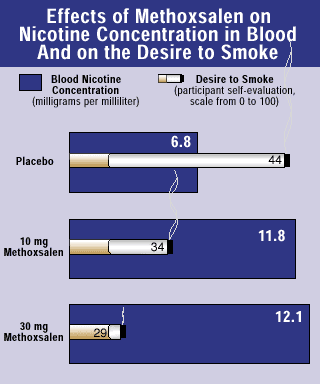NIDA-Funded Researchers Identify Compound That Inhibits Nicotine Metabolism, Decreases Urge to Smoke
Download PDF Version What is PDF?
Patrick Zickler
Patrick Zickler is a Staff Writer for NIDA NOTES.
Source: NIDA NOTES, Vol. 15, No. 5, October, 2000
Public Domain
Table of Contents (TOC)
Article: NIDA-Funded Researchers Identify Compound That Inhibits Nicotine Metabolism, Decreases Urge to SmokeReferences
In 1998, NIDA-supported investigators identified a genetic variation that makes some individuals less liable to become addicted to nicotine and, if addicted, more likely to smoke fewer cigarettes and have an easier time quitting than do individuals without the variation. Now the researchers have found that methoxsalen, a medication that mimics the effect of the genetic variation by partially blocking the body’s ability to break down nicotine, significantly improves the effectiveness of oral nicotine replacement in reducing a smoker’s urge for nicotine. And, according to Dr. Edward Sellers and his colleagues at the University of Toronto, when smokers who receive methoxsalen do light a cigarette, they take fewer and shorter puffs, thereby reducing their exposure to tobacco smoke’s carcinogenic components.
"These results suggest that methoxsalen, or other medications that act at the primary site of nicotine metabolism, may represent part of a potent new treatment for nicotine addiction," Dr. Sellers says. "Methoxsalen therapy could reduce smokers’ exposure to the harmful constituents of tobacco smoke while serving as part of a step-by-step program of smoking reduction leading to cessation."
 Addicted smokers maintain the nicotine in their blood at a concentration
that prevents the physical discomfort of withdrawal. They light up a
cigarette when that concentration falls. Many smokers who are trying
to quit rely on nicotine replacement by transdermal patch or nicotine
chewing gum to maintain nicotine levels without smoking. Regardless
of the nicotine’s source, the drug’s blood level falls as it is metabolized
by an enzyme produced in the liver, cytochrome P450 2A6 (or CYP2A6).
Addicted smokers maintain the nicotine in their blood at a concentration
that prevents the physical discomfort of withdrawal. They light up a
cigarette when that concentration falls. Many smokers who are trying
to quit rely on nicotine replacement by transdermal patch or nicotine
chewing gum to maintain nicotine levels without smoking. Regardless
of the nicotine’s source, the drug’s blood level falls as it is metabolized
by an enzyme produced in the liver, cytochrome P450 2A6 (or CYP2A6).
Dr. Sellers and his colleagues tested more than 200 medications to find compounds that decreased CYP2A6 activity. They found that methoxsalen, which currently is used in treatment regimens for severe psoriasis, reduces the activity of CYP2A6 and makes more nicotine-whether from a cigarette or nicotine replacement-available in the blood for longer. "We found that methoxsalen is a potent CYP2A6 inhibitor," Dr. Sellers says.
The researchers conducted two studies of methoxsalen’s effect on nicotine metabolism and craving for nicotine in smokers with normal CYP2A6 metabolism who were not trying to quit smoking. In one study, 17 smokers (8 men and 9 women) received methoxsalen or placebo in combination with oral nicotine replacement. Blood levels of nicotine were measured in samples taken at 30-minute intervals for 3 hours. Participants who received either 10 or 30 milligrams of methoxsalen had mean nicotine levels roughly twice as high as those given placebo. The participants also were asked at hourly intervals to rate their urge to smoke. Those who received methoxsalen reported far less desire to smoke.

Methoxsalen inhibits the normal liver metabolism of nicotine, and the resulting higher concentration of nicotine in the blood reduces a smoker’s desire to smoke. Horizontal bars indicate average blood nicotine concentrations measured 5 times during 3 hours following the administration of oral nicotine combined with placebo or methoxsalen. Cigarettes indicate the participants’ desire to smoke, rated from 0 (none) to 100 (strongest).
In a second study, 11 participants (5 men and 6 women, all of whom had participated in the first study) received either methoxsalen or placebo in combination with nicotine or placebo. Following a 60-minute abstinence, the participants were allowed to smoke at will for 90 minutes. Smokers who had received methoxsalen plus nicotine smoked fewer cigarettes, had longer intervals between cigarettes, and took fewer puffs on each cigarette.
 The doses of methoxsalen used in the studies are lower
than the dose approved for human use in treating psoriasis,
Dr. Sellers says, but the medication has not been proven
safe for long-term use in humans. "We need to establish
methoxsalen’s safety and efficacy in chronic use before
it could be used as part of any smoking cessation treatment," he
says.
The doses of methoxsalen used in the studies are lower
than the dose approved for human use in treating psoriasis,
Dr. Sellers says, but the medication has not been proven
safe for long-term use in humans. "We need to establish
methoxsalen’s safety and efficacy in chronic use before
it could be used as part of any smoking cessation treatment," he
says.
Methoxsalen offers several advantages as a part of treatment for smoking cessation, Dr. Sellers says. For example, it would make possible the use of a pill, rather than a patch or gum, for nicotine replacement. "Most patients prefer taking an oral medication, and there are places where gum is not appropriate," he says. And, because methoxsalen eliminates almost completely the activity of CYP2A6, which varies from person to person, its use with a nicotine pill could result in more predictable response to nicotine replacement than is possible with either patch or gum, Dr. Sellers says.

Participants were allowed to smoke at will for 90 minutes following the administration of combinations of placebo, oral nicotine, and 30 milligrams of methoxsalen. Participants who received methoxsalen and nicotine had significant reductions in the number of cigarettes smoked and carbon monoxide-one of tobacco smoke’s most harmful components-measured in breath.
Sellers, E.M.; Kaplan, H.L.; Tyndale, R.F. Inhibition of cytochrome P450 2A6 increases nicotine’s bioavailability and decreases smoking. Clinical Pharmacology and Therapeutics 68(1):35-43, 2000.


